|
Grant Wood 1891-1942
|
|
Grant Wood was born
on a farm near the small town of Anamosa, in 1891. By
painting simple scenes of the land and people he knew best,
he helped create an important, all-American style of art.
Grant Wood’s paintings show the love he had for the people
and customs of the Midwestern United States. Grant Wood
particularly loved the farmland of Iowa. While growing up,
he enjoyed feeling the soft, warm soil between his toes as
he walked barefoot through the fields. In his painting
Young Corn it seems like the round, friendly hills are
protecting the farmer and his children while they work in
their fields. |
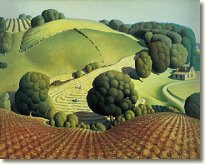 |
|
|
Grant Wood showed an interest in art
at a very early age. He often drew pictures with burnt sticks
his mother gave him from her stove. Even though Grant drew
pictures every chance he got, everyone thought he’d grow up to
be a farmer like his father. Grant seemed to enjoy his farm
chores, and had his own goats, chickens, ducks and turkeys.
When Grant was ten years old, a very sad thing happened to him.
His father died, and his mother found that it was too difficult
to keep the farm running. She decided to move her family to the
nearby city of Cedar Rapids. It was a hard move for Grant. He
missed his farm pets, and felt out of place at the new city
school. Some kids even made fun of him. Because of his good
sense of humor and his talent for drawing, things eventually got
better for Grant. In high school he made friends and was always
busy working on projects, like designing scenery for school
plays and drawing pictures for the school paper and yearbook.
After he graduated in 1910, Grant did a lot of different
things. He took art classes, taught art, made jewelry, learned
carpentry, decorated people’s houses and cared for his mother
and his sister Nan.
|
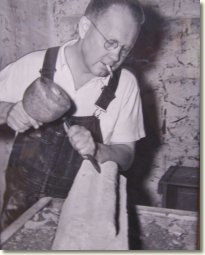 |
He loved gadgets and making
things, and he worked slowly and carefully at all of his
crafts. He was even able to use his artistic talent when he
joined the army during World War 1. His job was to paint
camouflage on tanks and cannons. During this time, American
art students were often encouraged to study and paint in the
style of the great 19th century French
Impressionist artists. In 1920, Grant decided to travel to
Europe to study artists like Pierre Bonnard, Alfred Sisley
and Camille Pissarro. It was after his trip to Germany that
Grant found a way to paint that was all his own. He decided
to paint the subjects he knew and loved, using some of the
simple ideas of the old European masters. Grant realized
that scenes of the people and places he knew while growing
up were as beautiful and important as anything he had seen
in Europe. |
|
|
In Woman with
Plants, Grant painted his mother as a strong and loving
frontier woman. He placed her in a farm landscape and paid
special attention to the decorative stitching on her dress,
the cameo around her neck, the potted plant and other
details that were important to her. People all over Iowa
were proud of Grant’s portrait of his mother. It was one of
the first paintings about the Midwest that seemed like it
was done by someone who really knew and understood the
people there. Grant kept working in his new style and soon
painted his most famous picture, American Gothic. |
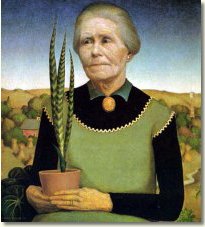 |
|
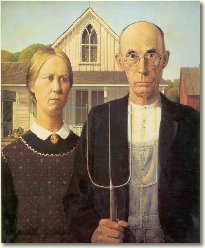 |
One day, while Grant
was looking for something interesting to paint, he
discovered a farmhouse with an unusual window. The
arch-shaped window was based on a style of European
architecture from the Middle Ages called Gothic
architecture. Grant liked the contrast of a European window
on an American farmhouse. After he made sketches of the
house, Grant looked for just the right people to go with
it. He thought his family dentist and his own sister, Nan,
would be perfect for the farmer and his daughter. Grant
entered American Gothic in a big show at the Art
Institute of Chicago, and won the third place prize. People
all over America loved the newspaper pictures they saw of
it. Soon, Grant’s paintings started to become very
popular. One reason for this was that many people felt
Grant’s art was easier to understand than a lot of the new
modern art being done. Another reason Grant’s paintings
became so popular was that they came along during a rough
time in history known as the Great Depression. |
|
|
The depression caused many people to lose their jobs and savings.
It made people feel better to look at Grant Wood’s painting
of beautiful farmlands and proud, hard-working families who
helped make America great. Grant also painted pictures of
famous American legends. While growing up, he had loved the
stories he heard about George Washington and Paul Revere.
In Midnight Ride of Paul Revere Grant showed the
story as he imagined it as a child. He painted
broccoli-shaped trees and toy-like houses. The roads go off
into the background and seem to glow in the dark. Grant
gave his painting an almost fairytale look. Paul Revere’s
horse even looks more like a wooden rocking horse than a
real horse! |
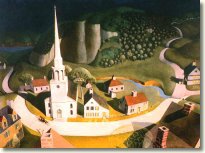 |
|
|
Grant also started an art
colony, and designed one of the largest stained glass windows
ever made. Grant wood died in 1942. It had taken him many
years to find a way to paint that he felt was special enough to
call his own. After searching the art center of Europe, Grant
had finally realized the best place to create art was right in
his own backyard. When Grant Wood painted American Gothic,
he was just having fun showing the people he had known all his
life. Some people thought Grant was making fun of farmers,
while others thought he was honoring them. One reason
American Gothic has become so popular is that very often
people see something in it that reminds them of themselves.
|
|
|
|
|
Copyright
© 2005-2012
Grant Wood Art Gallery |
|
|
|
|

